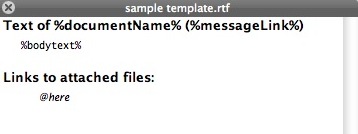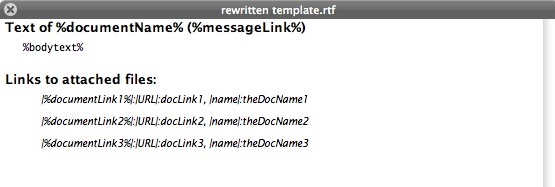While this topic has seen no activity for some time, I recently had a similar problem that required creating a template at run time, and thought the solution would be of general interest.
Here is a solution for the OP’s specific need to dynamically create a template at runtime. It can easily be modified for other needs.
-
Create a template such as (based on the information the OP gave):

Format it as you wish with fonts, indentations, etc. Save it to your desktop as “sample.rtf.”
-
Run “rewrite template example.scpt” (included at the end of this post). It will create on your desktop a new template, named “rewritten template.rtf,” based on sample.rtf, with “@here” replaced with the list of 1 - n new placeholders:

This solves the initial problem of dynamically creating a template at runtime. Note also that in the original “sample remplate.rtf,” “@here” was indented and italicized, and this formatting is retained in the text that replaced it; presumably, any text that replaces these placeholders will also have this formatting.
==============================
I’m not getting two things though:
-
Specifically concerning this use case: Where do the URL and name for the attachment come from, how in general is this link constructed, and what do the “|” represent? I’ve seen these used in working with files’ properties in DT scripts, but I’m still confused by their use.
-
In general when using this approach: How in script to construct the placeholder list dynamically at runtime?
In this specific use case (importing a mail message that has attachments), we can assume that we’d know the details of the message(s) and each of their attachments. For example:
tell application "Mail"
set messageDetails to {}
set theMessages to selection
repeat with msg in theMessages
set msgDetails to {subj:subject of msg, msgLink:sender of msg, bodytext:content of msg}
set attach to {}
repeat with theAttachment in mail attachments of msg
set listItem to {attachName:name of attach}
end repeat
(* the template calls for: |%documentLink1%|:|URL|:docLink1, |name|:theDocName1 ... |%documentLink-n%|: etc...
- how are these derived from the message and attachments?
- how to prepare the list of placeholders from 1 to n at runtime to pass the placeholders to import?
*)
end repeat
end tell
Granted, the placeholders parameter to import is just a list, and would include (based on the information the OP gave):
set thePlaceholders to {|%documentName%|:subj of msg, |%messageLink%|:msgLink of msg, |%bodytext%|:content of msg}
But, how to construct the list elements to accommodate from 1 to n of:
|%documentLinkn%|:|URL|:docLinkn, |name|:theDocNamen
I expect the script would have to add placeholders to the list, in some way such as:
repeat with ctr from 1 to (count of attach)
set a to item ctr of attach
set listItem to {}
-- set list item to what?
-- we want the URL of the attachment (which is stored in docLink1, and the name from the attachment (which is stored in theDocName1): {|%documentLink1%|:|URL|:docLink1, |name|:theDocName1}
-- how are these extracted from the attachment?
-- generating the text itself it not a problem:
set theString to "|%documentName" & (ctr as string) & "%|:" -- but what else?
set listItem to {} -- set it to what?
copy listItem to end of thePlaceholders
end repeat
So that the script can import the template and have DT do the replacements:
set pathToRewrittenTemplate to "/Users/Me/Desktop/rewritten template.rtf"
tell application id "com.devon-technologies.thinkpro2"
set theRec to import pathToRewrittenTemplate name "New Record" placeholders thePlaceholders
end tell
But the problems are adding the rest of the information about the link, and adding this to the placeholders list. It almost seems that this problem requires somehow modifying the script itself at runtime, or creating an AppleScript at runtime and loading and executing the dynamically-created script at runtime.
Having said all this, I wonder if it’s simpler to just open the template file, find @here, and instead of replacing it with placeholders, inserting the needed actual content into the rtf document, saving it, and importing it into DT, without using any placeholders in the call to import.
(But I sure would like to know how to create those clickable links to emails, and clickable links in general!)
==============================
rewrite template example.scpt follows
(* rewrite template example
create a set of 1-n placeholders and write them to an rtf template file to be used with DT's "import" verb.
to use, create an rtf template file and save it to your desktop as "sample.rtf". in this template, place the templateFileToken defined below where you want the placeholders to be.
the script wil generate numAttachments sets of placeholders, replace the templateFileToken with them, and write the new template to your desktop named "rewritten template.rtf".
script assumes one message and "numAttachments" attachments.
*)
-- --------------------
-- set these as appropriate.
-- pathToTemplateFile and pathToNewTemplateFile must be POSIX paths.
set pathToTemplateFile to "/Users/<<YourUserName>>/Desktop/sample template.rtf"
set pathToNewTemplateFile to "/Users/<<YourUserName>>/Desktop/rewritten template.rtf"
-- the script looks for this token in the template file and replaces it with the new placeholders.
set templateFileToken to "@here"
-- for how many attachments do you want the new placeholders to be generated?
set numAttachments to 3
-- used in generating the new placeholders.
set counterPlaceholder to "@"
-- used to separate the new placeholders in the new template file (consider this like the rtf equivalent of html's <p>)
-- (the actual markup is \par, but AppleScript requires \\par because it uses \ as an escape character)
set rtfNewPar to "\\par"
-- the instances of counterPlaceHolder will be replaced with a number.
set myPlaceholders to "|%documentLink" & counterPlaceholder & "%|:{|URL|:docLink" & counterPlaceholder & ", |name|:theDocName" & counterPlaceholder & "}" & rtfNewPar
set templateData to ""
-- ====================
-- generate numAttachments instances of placeholders, unsing myPlaceholders as the template, and replacing counterPlaceholder with the instance number.
set newPlaceholders to generatePlaceholders(myPlaceholders, counterPlaceholder, numAttachments)
-- read the original template.
set templateData to readFile(pathToTemplateFile)
-- replace templateFileToken with the new placeholders.
set newTemplateData to replaceText(templateFileToken, newPlaceholders, templateData)
-- write the new template file.
writeNewTemplate(newTemplateData, pathToNewTemplateFile)
-- uncomment if you're curious about what the rtf markup looks like
-- set the clipboard to newTemplateData
return
-- ====================
on generatePlaceholders(placeholders, replaceWhat, numAttachments)
set rtnText to ""
repeat with ctr from 1 to numAttachments
set rtnText to rtnText & replaceText(replaceWhat, (ctr as string), placeholders)
end repeat
return rtnText
end generatePlaceholders
-- --------------------
on replaceText(find, replace, inWhat)
set delims to AppleScript's text item delimiters
set AppleScript's text item delimiters to find
set txt to text items of inWhat
set AppleScript's text item delimiters to replace
set txt to "" & txt
set AppleScript's text item delimiters to delims
return txt
end replaceText
-- --------------------
on readFile(pathToFile)
try
set siz to getFileSize(pathToFile)
set f to open for access pathToFile
set txt to read f from 1 to siz
close access f
on error errMsg
display dialog errMsg
end try
return txt
end readFile
-- --------------------
on getFileSize(pathToFile)
-- simply using read file of read from 1 to eof does not read the entire file, only 1,199 bytes.
-- perhaps applescript chokes on some sequence of characters that it believes represents end of file?
-- using this command line seems a fast way to get the size of the file so that it can be completely read.
set cmdLine to "ls -l " & quoted form of pathToFile & " | awk '{print $5m}'"
set fileSize to ((do shell script cmdLine) as integer)
return fileSize
end getFileSize
-- --------------------
on writeNewTemplate(theData, pathToFile)
try
set f to open for access pathToFile with write permission
write theData to f
close access f
on error errMsg
display dialog errMsg
end try
end writeNewTemplate

